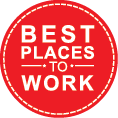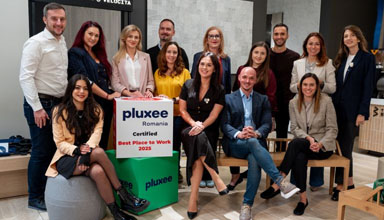
In today's increasingly competitive and rapidly changing business environment, the pursuit of becoming a "Best Place to Work" seems more about building a people-focused culture-one that adds value and empowers staff members from all levels-rather than the offering of perks or benefits. Time after time, organisations recognised as Best Places to Work have identified that the combination of engagement, inclusion, learning, and retention is at the heart of driving success. This article takes a closer look at what sets such organizations apart in strategic terms and at how they create an environment in which employees can thrive and deliver great business outcomes.
Employee Engagement: The Heart of a People-First Strategy
At the core of any Best Place to Work is a deeply engrained commitment to employee engagement. Companies who do this well realize that an engaged employee would provide superior results, be more productive, and add much to the workplace culture. Examples of engagement initiatives include:
Empowerment-allowing employees to make some decisions-creates ownership, just as in Hyatt, and when people feel trusted, they are likely to work even harder. Recognition & Rewards: Celebration of employee achievements through formal recognition programs will reinforce commitment and satisfaction. The more frequently they receive recognition, the more likely to continue their efforts, linking personal goals with organizational success.
Open Communication: It is very important to facilitate two-way communication. Feedback sessions, employee forums, and open-door policies are some of the techniques that make employees feel heard and valued.
For organizations that have set goals to become one of the Best Places to Work, it's paramount to make the employee journey-from onboarding to career growth-a delight to experience. Engaged employees translate into a better retention rate, and with it comes business growth.
Learning & Development: Investing in Employee Growth
Leading organizations know continuous learning and career development are cornerstones to a successful workforce. The best employers provide robust opportunities for skill development and personal growth, ensuring their teams are not only ready to meet the challenges of the business today, but positioned for future opportunities.
Learning-oriented companies offer:
Training Programs: Extensive in-house and external programs, including leadership development and soft skills training, give ample avenues for employees to grow into their roles.
Mentorship & Coaching:
Building formal and informal mentorship programs helps strengthen collaboration and accelerates learning. Employees are encouraged to seek guidance from senior staff on specific issues; this sets the culture of knowledge sharing.
Tuition Reimbursement:
Financial support extended for acquiring external educational opportunities, like certification courses or even degrees, speaks volumes for personal growth that a firm undertakes commitment for.
This investment in human capital equips the organization to be a learning organization that creates, adapts, and innovates constantly while motivating and enabling employees with the right set of skills.
Diversity & Inclusion: Building a Culture of Belonging
Diversity, equity, and inclusion are keystone elements in becoming a Best Place to Work. A company with an inclusive workplace creates a feeling of belonging for all employees from every walk of life and taps into the full capability of its workforce.
Best Places to Work strive to achieve the following:
Inclusive Leadership: The leadership teams create an environment where there is active demonstration of diverse thought, minimizing bias, and nurturing inclusive behaviors, letting everyone be their authentic best.
Employee Resource Groups: Shared identity and interest-based ERGs provide employee connections, support, and enable the drive for diversity and inclusion at every level.
Targeted Recruitment & Support: Targeting recruits from diverse communities and fostering a range of support networks-from women's and veterans' to LGBTQ+ employee organizations-ensures a deep talent pipeline that reflects myriad experiences and ideas.
The commitment to diversity is not only the right thing to do, but it also shows a significant effect on business performance. Firms with diverse teams show increased creativity, better problem-solving ability, and improved financial performance.
Retention: Retaining top talents is one of the hallmarks of the Best Places to Work, and the top-scoring organizations realize that it takes more than competitive salaries to retain their best people-engaged, motivated, and loyal. To retain their best people-engaged, motivated, and loyal-leading companies offer a suite of strategies, including:
Career Development Opportunities: Clearly defined career development paths are established in terms of the potential for advancement, internal mobility, and succession planning, allowing people to envision long-term futures with the company.
Flexible Work Arrangements: Offering remote work opportunities, flex hours, and family-friendly policies-extended parental leaves-foster employees' work-life balance more favorably, thus having an increased likelihood of staying with a company.
Wellness and Benefits: Thorough benefits packages mean health cover, retirement plans, and wellness activities that mean something to an employee.
Indeed, the Best Places to Work follow through with employee feedback via engagement surveys, stay interviews, and even exit interviews to collect data points used to fine-tune their retention strategies for incremental satisfaction over time.
Technology: Making People Processes Efficient
Organizations offering technology support to enhance the experience of employees are ultimately regarded as top employers. By deploying advanced tools such as :
Talent Management Systems: Such systems house recruiting, learning, and performance processes all under one roof to ensure line-of-sight employee experiences from hire to retire.
Employee Feedback Tools: In-company real-time feedback empowers them to tune in with the needs of employees, while analytics unlock important insights that can drive much-needed improvement in engagement, retention, and diversity. All this is achieved by integrating the correct technologies that enable scaling of people strategies and making data-driven decisions to benefit both the people and the organization.
Conclusion: Excellence Through People-Centricity
The cultures of those organizations that invest in their people are typified by a sense of empowerment, inclusion, and support for employees. It's an excellent mix of great engagement, continuous learning, inclusive practices, and an keen focus on the well-being of employees that starts laying the foundation to make one an Best Place to Work. Self-evidently, higher retention, superior business performance, and the reputation for excellence become the ensuing returns for them.
By embracing a people-first culture, companies can unlock the full potential of their workforce, foster enduring loyalty, and achieve long-term success.



